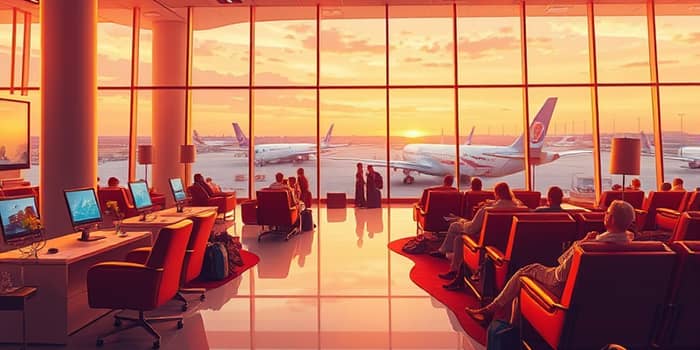
Traveling can be exhilarating: the thrill of a new city, the promise of unexpected discoveries. Yet airport terminals often feel overwhelming—long security lines, cramped seating, and overpriced food. Thankfully, premium credit cards have redefined pre-flight comfort by offering unlimited complimentary lounge access to cardholders.
Stepping into a quiet lounge can feel like entering a different world. Plush seating, soft lighting, and attentive staff transform minutes of wait time into moments of relaxation or productivity. This article unveils how travel cards have democratized lounge access and transform your journey into an experience, guiding you to choose and maximize the best options for your unique journey.
Airport lounges began as exclusive retreats for first-class and a handful of business-class passengers. In the 1960s, financier Loungescape opened the first private lounge in New York, inviting only top-tier travelers. Back then, access was a badge of honor, signaling status and privilege.
Fast-forward to the 2000s, when airlines and credit card issuers saw an opportunity to monetize comfort. They partnered with independent lounge networks, launching programs like Priority Pass in 1992. Over the next decade, Priority Pass grew to serve travelers regardless of airline loyalty.
Today, lounge access is a coveted perk tied to premium travel cards. Major issuers such as American Express, Chase, and Capital One have built extensive portfolios where each card tier unlocks a different set of lounges around the globe.
The result is clear: over 1,300 lounges in more than 500 cities are now reachable by simply carrying the right card. What was once an exclusive perk is now a powerful tool in every traveler’s arsenal.
The pathways to lounge entry can be confusing at first glance. Below are the primary channels through which travelers gain entry, along with their advantages and drawbacks:
Choosing the right type depends on your travel frequency, preferred airlines, and budget. For example, an annual subscriber to an airline network may find better value if they fly mostly with one carrier, while a Priority Pass member enjoys broader airport coverage.
Guest policies vary as well. Some cards allow two guests free, while others charge $50–$75 per additional visitor. Understanding these nuances can optimize your out-of-pocket expenses.
When assessing premium travel cards, lounge access often steals the spotlight. Below is a snapshot of some leading options in 2025, followed by an analysis of their strengths and trade-offs:
The Amex Platinum, while carrying the highest fee, excels with a vast proprietary network and generous credits. The Venture X card strikes a balance between cost and benefits, especially for mid-tier travelers seeking bundled perks increase overall value. Chase Sapphire Reserve remains a favorite for its robust travel insurance and door-to-door service, though guest policies are evolving.
Conversely, airline-specific cards like AAdvantage Executive appeal to brand loyalists. Their unlimited guest access and exclusive perks, such as companion certificates, can outweigh general-purpose networks for frequent flyers on a single carrier.
Step inside most lounges, and you’ll discover more than just a comfortable seat. They are designed to address the pain points of modern travel:
Top-tier lounges, such as Amex Centurion and select Priority Pass locations, often feature chef-crafted menus, curated wine lists, and even on-demand massage services. Whether you need to send a quick email or unwind with a glass of champagne, the environment caters to every traveler’s need.
Evaluating the true cost of a premium travel card extends beyond its annual fee. Consider a typical lounge trip replaces a $20 airport meal. If your card delivers two lounge visits per month, you save around $480 yearly—nearly covering the fee on some products.
Frequent business travelers who log 50 flights over two years can average savings of $1,000 or more by consistently choosing lounge amenities over terminal purchases. Many cards also include an annual $200–$300 travel credit, further reducing net costs.
It’s important to factor in non-quantifiable benefits. The ability to hold meetings in a quiet lounge, rest in a private suite during long layovers, or refresh with a hot shower can translate to improved productivity and well-being, especially during cross-time-zone travel.
Ultimately, the calculation is as personal as your travel habits. A break-even point around ten visits annually means many travelers tip in favor of premium cards.
As airport lounges surge in popularity, issuers are fine-tuning their offerings. Recent changes include:
• Stricter guest policies, introducing fees for additional companions.
• Higher annual fees aligned with enhanced lounge experiences and expanded networks.
• Tiered membership models, where customers must spend thresholds to unlock all lounge tiers.
Lounges themselves are innovating to maintain exclusivity and safety. Post-pandemic trends feature socially distanced seating layouts, digital menu ordering, and touch-free check-in processes. Some airports even launch outdoor terrace lounges, combining fresh air with panoramic runway views.
To ensure every dollar spent on fees delivers value, apply these recommendations:
By adopting a strategic approach, you can amplify both tangible savings and travel enjoyment.
Airport lounge access has transcended its status as an exclusive perk. It has become a practical necessity for travelers seeking comfort, efficiency, and occasional luxury. With the right travel card and a clear understanding of policies, you can turn hours of waiting into rejuvenating experiences.
Embrace the power of premium lounge access to enhance your next journey. From secluded corners where work feels effortless to gourmet bites that redefine airport dining, lounges open a new dimension in travel. Step inside, savor the calm, and discover how a simple perk can redefine your world.
As you explore, stay adaptable—lounge landscapes evolve rapidly. But one constant remains: great journeys begin the moment you leave the terminal gate behind.
References













